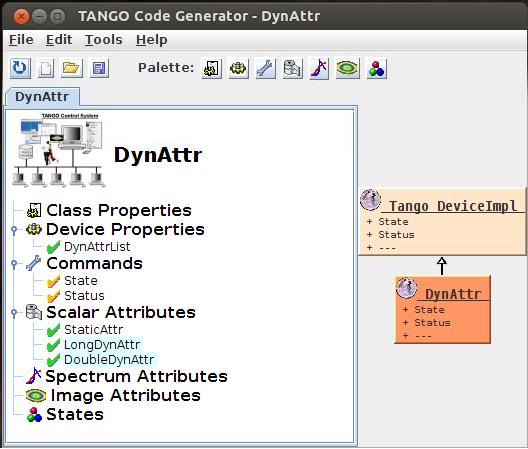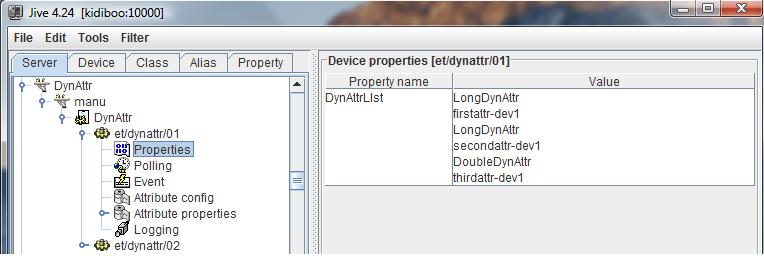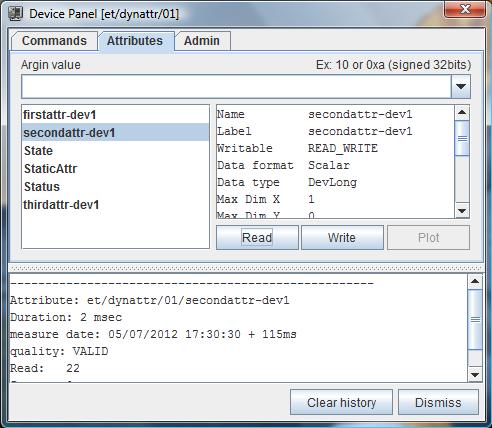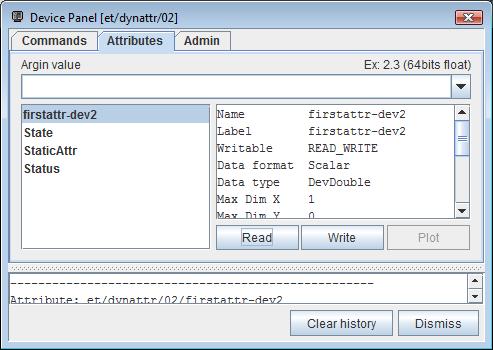How to add dynamic attributes to a device class
Intended audience: advanced developers, Programming language: c++
Creating new attributes at Startup
by Sergi Rubio Manrique, srubio@cells.es, with help from R.Bourtembourg and E.Taurel.
Do you need to create more or less Attributes depending on a certain device property? Are you interested in changing the name/type/dimensions of your attributes depending on different applications?
That is common while working with Input/Output devices with a variable number of channels (PLCs, DaqBoards, Timers/Counters), when depending of the operation mode more or less scalar or spectrum attributes could be needed.
This brief HowTo implements this feature in a Tango class base on code generated by Pogo 8.
Generating your class with Pogo
DynAttr
with three types of attributes:
StaticAttr: A scalar, Tango::DevShort, READ attribute,
LongDynAttr: A scalar, Tango::DevLong, READ_WRITE attribute,
DoubleDynAttr: A scalar, Tango::DevDouble, READ_WRITE attribute.
Each device belonging to this class has one StaticAttr and a dynamic list of LongDynAttr or DoubleDynAttr attributes. This list of dynamic attributes is defined with a device property named DynAttrList
Therefore, using Pogo, we define a Tango class with three scalar attributes with the definition given above. We also create the DynAttrList property for defining dynamic attribute. This is a vector of strings with a couple of strings for each attribute. The first string is the dynamic attribute type (LongDynAttr or DoubleDynAttr) and the second string is the attribute name.
Note
The dynamic attributes have a light green background color on the main Pogo window.

Implementing the Dynamic Attributes
Pogo 8 has been modified to help user to create Tango class with dynamic attribute(s).
Dynamic attribute registration
To register device dynamic attribute, you need to:
call the Tango::DeviceImpl::add_attribute() method for each device dynamic attribute.
create the data used with the attribute (for the Attribute::set_value() method).
Pogo generates method(s) named DynAttr::add_<Dyn attr class name>_dynamic_attribute(string att_name) which do this job for you. You have to call these methods according to your needs in another Pogo generated method named DynAttr::add_dynamic_attributes() which is executed at device creation time. In our example, in this method we have to:
analyze the content of the device DynAttrList property and create the necessary attributes using the helper method also generated by Pogo
The code of the DynAttr::add_dynamic_attributes() method looks like
1void DynAttr::add_dynamic_attributes()
2{
3 // Example to add dynamic attribute:
4 // add_LongDynAttr_dynamic_attribute("MyAttribute");
5 // add_DoubleDynAttr_dynamic_attribute("MyAttribute");
6
7 /*----- PROTECTED REGION ID(DynAttr::add_dynamic_attributes) ENABLED START -----*/
8
9 if (dynAttrList.empty() == false)
10 {
11 if ((dynAttrList.size() % 2) != 0)
12 {
13// Throw exception
14 }
15
16 for (unsigned int i = 0;i < dynAttrList.size();i = i + 2)
17 {
18 if (dynAttrList[i] == "LongDynAttr")
19 {
20 add_LongDynAttr_dynamic_attribute(dynAttrList[i + 1]);
21 }
22 else if (dynAttrList[i] == "DoubleDynAttr")
23 {
24 add_DoubleDynamicAttr_dynamic_attribute(dynAttrList[i + 1]);
25 }
26 else
27 {
28// Throw exception
29 }
30 }
31 }
32
33 /*----- PROTECTED REGION END -----*/ // DynAttr::add_dynamic_attributes
The code to throw exception has been removed.
Note
The data associated with all LongDynAttr dynamic attributes are initialized to 0 and the data associated to all DoubleDynAttr dynamic attributes are initialized with 0.0
The definition of the DoubleDynAttr attribute is simply to return when read, the last value which has been written. The code for the DoubleDynAttr reading/writing is the following
1void DynAttr::read_DoubleDynAttr(Tango::Attribute &attr)
2{
3 DEBUG_STREAM << "DynAttr::read_DoubleDynAttr(Tango::Attribute &attr) entering... " << endl;
4 Tango::DevDouble *att_value = get_DoubleDynAttr_data_ptr(attr.get_name());
5
6 /*----- PROTECTED REGION ID(DynAttr::read_DoubleDynAttr) ENABLED START -----*/
7
8 // Set the attribute value
9 attr.set_value(att_value);
10
11 /*----- PROTECTED REGION END -----*/ // DynAttr::read_DoubleDynAttr
12}
13
14void DynAttr::write_DoubleDynAttr(Tango::WAttribute &attr)
15{
16 DEBUG_STREAM << "DynAttr::write_DoubleDynAttr(Tango::Attribute &attr) entering... " << endl;
17
18 // Retrieve write value
19 Tango::DevDouble w_val;
20 attr.get_write_value(w_val);
21
22 /*----- PROTECTED REGION ID(DynAttr::write_DoubleDynAttr) ENABLED START -----*/
23
24 Tango::DevDouble *att_value = get_DoubleDynAttr_data_ptr(attr.get_name());
25 *att_value = w_val;
26
27 /*----- PROTECTED REGION END -----*/ // DynAttr::write_DoubleDynAttr
28}
The code of the read method in it’s Pogo generated part retrieves a pointer to the data associated with this attribute with the helper method named DynAttr::get_<Dyn attr class name>_data_ptr(sting att_name). The user code simply pass this pointer to the Tango Attribute::set_value() method.
The user code of the write method also uses the Pogo generated helper method to get the attribute data pointer and set this data to the value sent by the caller.
The definition of the LongDynAttr is a bit more sophisticated. For one device of this Tango class, we have several dynamic attributes of this LongDynAttr type. According to which attribute is read or written, we have to call different method accessing the hardware.
The code for reading/writing the LongDynAttr attribute is given below:
1void DynAttr::read_LongDynAttr(Tango::Attribute &attr)
2{
3 DEBUG_STREAM << "DynAttr::read_LongDynAttr(Tango::Attribute &attr) entering... " << endl;
4 Tango::DevLong *att_value = get_LongDynAttr_data_ptr(attr.get_name());
5
6 /*----- PROTECTED REGION ID(DynAttr::read_LongDynAttr) ENABLED START -----*/
7
8 string &att_name = attr.get_name();
9 if (att_name == dynAttrList[1])
10 *att_value = read_hardware_channel1(); // Access hardware for channel 1 which is the first attribute in the list
11 else if (att_name == dynAttrList[3])
12 *att_value = read_hardware_channel2(); // Access hardware for channel 2 which is the second attribute in the list
13 else
14 {
15// Throw exception
16 }
17
18 // Set the attribute value
19 attr.set_value(att_value);
20
21 /*----- PROTECTED REGION END -----*/ // DynAttr::read_LongDynAttr
22}
23
24void DynAttr::write_LongDynAttr(Tango::WAttribute &attr)
25{
26 DEBUG_STREAM << "DynAttr::write_LongDynAttr(Tango::Attribute &attr) entering... " << endl;
27
28 // Retrieve write value
29 Tango::DevLong w_val;
30 attr.get_write_value(w_val);
31
32 /*----- PROTECTED REGION ID(DynAttr::write_LongDynAttr) ENABLED START -----*/
33
34 string &att_name = attr.get_name();
35 if (att_name == dynAttrList[1])
36 write_hardware_channel1(w_val); // Access hardware for channel 1 which is the first attribute in the list
37 else if (att_name == dynAttrList[3])
38 write_hardware_channel2(w_val); // Access hardware for channel 2 which is the second attribute in the list
39 else
40 {
41// Throw exception
42 }
43
44 /*----- PROTECTED REGION END -----*/ // DynAttr::write_LongDynAttr
45}
Running the server
A Tango device server process hosting this DynAttr class has been defined in the database with two device. The dynamic attributes for these two devices are:


As shown by the Pogo screen-shot in the beginning of this HowTo, the Tango class also defines a static attribute for each device named StaticAttr. Running the device server and opening TestDevice panels on each device displays device attribute list:


This method fully supports restarting device(s) or server using the device server process admin device.
Conclusion
Pogo 8 simplifies a lot the code needed to write Tango class with dynamic attributes. Restarting device(s) from the admin device is fully supported.